Sameer Family History & Genealogy
Sameer Last Name History & Origin
AddHistory
We don't have any information on the history of the Sameer name. Have information to share?
Name Origin
We don't have any information on the origins of the Sameer name. Have information to share?
Spellings & Pronunciations
We don't have any alternate spellings or pronunciation information on the Sameer name. Have information to share?
Nationality & Ethnicity
We don't have any information on the nationality / ethnicity of the Sameer name. Have information to share?
Famous People named Sameer
Are there famous people from the Sameer family? Share their story.
Early Sameers
Sameer Family Members
Sameer Family Photos
Discover Sameer family photos shared by the community. These photos contain people and places related to the Sameer last name.
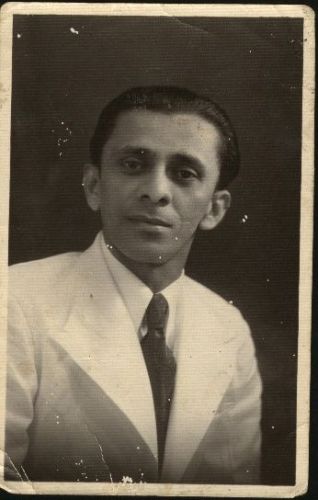
People in photo include: Muhammad Thahir Sameer
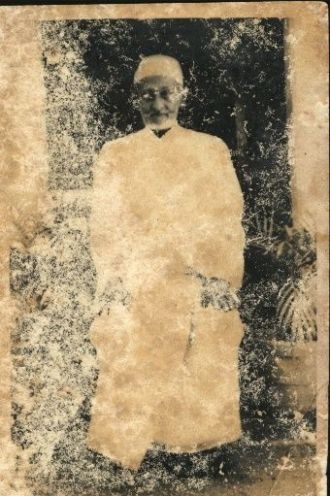
People in photo include: Muhammad Cassim Hajiar
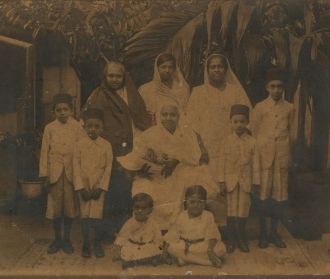
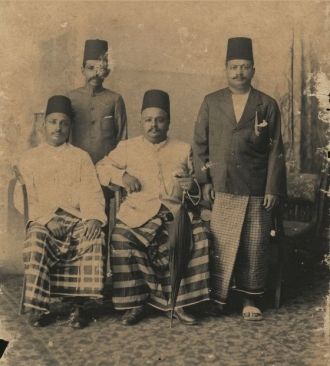
People in photo include: Abdul Majeed, Abdul Jabbar, and Mohammed Sheriff
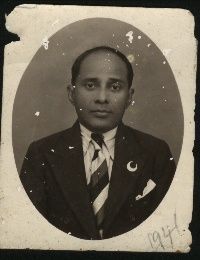
People in photo include: Mohammed Sameer
Sameer Family Tree
Discover the most common names, oldest records and life expectancy of people with the last name Sameer.
Other Sameer Records
Share memories about your Sameer family
Leave comments and ask questions related to the Sameer family.
The following account of the peregrinations made by Sahib Dorai Ismail Lebbe Marikar Alim (born 23 August, 1854; died 11 January, 1896) - later SD Haji Ismail Effendi - in 1884, in the company of,
(I) Yousoof Lebbe Sinne Lebbe Marikar Hajiar (later, Haji, Effendi), grandfather of MHM. Yousoof Haji),
(ii) Muhammad Lebbe Marikar Haji Zainudeen (later Haji, Effendi, and MMC, grandfather of Mrs. MMI.
Kariappar),
(iii) Ahmed Lebbe Marikar Samshi Lebbe Marikar (later, Haji, Effendi, father of SLM. Abdul Rahman),
(iv) Sinne Lebbe Marikar Mahmood (later, Haji, Effendi, and Alim, father f MHM. Yousoof Haji) and
(v) Rawthen Hajiar (Cook).
This account, from the beginning t end of the journey in Istanbul, Turkey is now translated into English by Sithy Rameela Sameer (w/o AWM. Ghouse), the eldest daughter of Muhammad Sameer son of Haji Ismail Effendi.
May Allah be pleased with him!
8 January 1971 Muhammad Sameer
298, Bambalapitiya Road
Colombo 4
Sri Lanka
When I was young I was very anxious to travel in foreign lands but was helpless. Some Ulema taught me a little knowledge of the Arabic language. I read the Holy Quran and discovered that, based on several verses contained within it, people of the old days considered embarking on journeys and seeking knowledge and experiences an essential requisite for believers as follows:-
Quran Surah AnAm (6:11)
“Say, Go about in the earth and see what was the end of those who treated the Prophets as liars”
Quran Surah Yusuf (12:109)
“Have they no then traveled in he Earth and seen who was the end of hose before them?”
Quran Surah Naml (27:63)
“He guides you in every kind of darkness of the land of the sea, and sends the winds as glad tidings”
Quran Surah Ankabuth (29:20)
“Travel in the earth and see how He originated the creation”
Quran Surah Fatir (35:40)
“Show Me then what they have created of the Earth”
Quran Surah Moomin (40:21)
“Have they not traveled in the Earth and seen what was the end of those before them?”
Quran Surah Muhammad (47:10)
“Have they not traveled in the Earth and seen what was the end of those who were before them?”
Quran Surah Mulk (67:15)
“He it is Who made the Earth, even and smooth, for you, so traverse through its sides”
And, it is also revealed in many other verses, of the blessings and the esteem in life of undertaking journeys. Prophet Muhammad (Sal) and his followers traveled in other ands and, by this Islam was spread across the globe.
According to Imam Shafi,
“To seek a position you must travel, from the place of birth, and you will know five things. First, you will get rid of your worries, second, ..., third, you will gain knowledge, fourth, you will learn manners and fifth, you will obtain the friendship of noble men.”
My mind never turned away from the thought of travel as my ambition was not fulfilled.
Late on, when Ahmed Arabi Pasha came from Egypt to Ceylon, we used to meet at his house and he used to talk about Egypt. Sinne Lebbe Marikar, his brother’s son, Zainudeen, and Sinne Lebbe Mahmood were amongst us.
One day, Zainudeen told me that he wished to travel to Makkah to perform the pilgrimage of Hajj and also visit other places abroad. On another occasion, at Mahmood Pasha Samy’s house, when I was present with Sinne Lebbe I too indicated my desire to travel to Makkah. Mahmood Pasha was very pleased with me and indicated that only a few Muslims from Sri Lanka would embark on he pilgrimage on account f he majority of them being poor, especially in external affairs and manners. He said that it would be very useful if I would undertake this trip, ravel beyond the seas, and learn about Islam. By this more Muslims in Ceylon would benefit from the knowledge and experience gathered.
I was very encouraged by such statements. I agreed with Zainudeen and joined Sinne Lebbe and started preparing for the journey. Shamsi Lebbe Marikar Ahmed Lebbe Marikar’s son. Shams Lebbe Marilkar also agreed to join us. Packeer Thamby Sinne Lebbe Marikar brought his son, Mahmood, along ad asked us to take him along too. We also asked a cook, Rawthen Hajiar, to join us.
During our preparations, some Muslims who were jealous of this adventure, tried to convince us that the Afghans were against the British Government (Afghan war) ad they they were planning to attack British ships. Some of my friends changed their minds on these instigation’s of these half-educated Mullahs. Some even endeavored to mislead my friends through similar false statements. We ignored them and prepared for our journey, confirmed our date of departure by sea and requested a friend to obtain our tickets for the planned days. Some even attempted to influence this friend to tell us that no tickets were available. This disturbed many of us. Then Yousoof Lebbe Muhammad Lebbe Marikar (father of Zainudeen) volunteered to obtain he tickets for us himself and conveyed this good news to me which brought about some satisfaction amongst us. He was successful and we thanked him profusely for his assistance. Ahmed Arabi Pasha gave me some letters to be delivered to his family in Egypt ad I had to conceal them inside my pillowcase for fear of being found out by the British authorities who had exiled him.
Many of our people, Muslims, friends, Lemmas and Khatheebs, accompanied us to the harbor on the day of our departure. We then boarded the Steamer SS Malwa. an friends and family visited us on board until the ship set sail the next day, the 27 March, 1884., at 12:00 Noon.
Fearing sea-sickness we confined ourselves to our rooms. After about a hour we came out and watched the mainland going out of sight. The next day we saw nothing the sea and sky all around us until we finally sighted the Malabar coast of India.
On April 1, 1884, we arrived a Bombay Harbor, ad there, we saw thirty seven steamers, loading ad unloading goods. We disembarked and went to look at the town. We saw many large buildings high roads, and various different kinds of people, tramways, a kind of iron carriage pulled by horses, and buggy carts. There were also beautiful markets. In one of them, built with iron gates and having electric lamps, by which everything was illuminated, we saw a factory where silk cloth was made. Free access to the factory was not allowed. Yet, with the help of some high officials we were able to enter inside ad inspect the factory. There were laborers, both male and female, about five hundred in all.
In Bombay we also saw Gahuwa (Coffee) Cafe Hotels where Arab merchants kept their businesses opened till late at night. On May 7, 1884, we embarked the good ship SS Austria-Hungary, belonging to the Royal Company - Thabuk Steamer - and set sail once again.
For six days the sea was calm. We spent time enjoying the reminisces of home. We bathed every day. We also conversed with Austrian passengers on board. On the seventh and eighth days the sea became very rough. We spent most of or time within our rooms. he next day we noticed the lights on the shores of the coast of Aden. e hen entered the Red Sea and saw land on the other side. We also noticed the points of Muqa and Aukandry. From in between these two we also saw the tomb of Sheikh Syed Rahmatullah and supplicated Allah to Bless him. While passing through we witnessed land and mountains on both sides of the Red Sea. At one point we saw a huge rock called Dadloos. At night a lamp s placed on top of it in order to guide steamers. We noticed several ships wrecked, misguided y the rock. Passing this we saw another light, and then he African mountains; besides these we saw Pyramids, and, by their sides, Arab caretakers’ huts. At another point we saw two pieces of land joined together with two mountains upon them. They were named a
Followers & Sources

The Arab’s came to Ceylon in the pursuit of trade and also to visit Adam’s Peak. The earliest record, by a Moor, of the existence of a Prince in Colombo is that of Ibn-Batuta in AD 1343-1344.
He states, “We took our departure for the town of Kaly (Galle), a small town, six parasangs from Dinewer (Dondra). A Muslim called, Ship Captain Ibrahim, entertained us at his house. We then took the route for the town of Colenbou (Colombo), one of the largest and most beautiful in the Island os Serendib (Ceylon). There dwelt the Vizier, Prince of the Sea, DJALTESTY, who had about five hundred Abyssinians.”
In 1505, when the Portuguese, piloted by the Moors, came to Colombo from Galle, they saw two white-washed Mosques there. (See Surveyor General’s Map Historical Series No.1, Portuguese Period). It is recorded, “The first Portuguese to put into Colombo did so by accident. Don Laurenzo de Almeida, son of the Viceroy, Fransisco de Almeida of Goa, set out from Cochin, in the month of November 1505, with nine sailing ships and made for the Maldive Islands, hoping to intecept Moorish ships bound for Makkah. Being carried away by a storm and reaching the Port of Galle, and after victualling, the ships followed the coastline, Northwards, to the Port of Colombo in which the anchored, causing much astonishment to the natives and tremendous grief to the Moors.”
“Passing coconut gardens and thatched roofs, as Colombo came into view, they saw the white walls of the two Mosques, sailing ships and fishing craft.”
The precise location of these Mosques are doubtful. There was one at Gabokka where the new lighthouse stands. The other could have been the Grand Mosque at New Moor Street, being situated on a hill and hence visible from the sea. According to another version, there was a Mosque on the hill at Wolvendhal, and that part of Colombo was an open space fully visible from the sea. This Mosque was being used by Arabs for prayer, who had their go-downs, moored, in the harbor. The had complete freedom in the Island and a large majority of them monopolized the coastal areas in rder to be in close contact with their sailing vessels. The advent of the Portuguese brought intolerance and business rivalry and the Moors had to move to the outskirts of Colombo by a “Road to Cotta”, now called Maradana Road, and settled therein. The more powerful and wealthy of them mustered strongly at Moorish quarters at Grand Moor Street (ie the Pettah section of of Main Street), New Moor Street, Old Moor Street, Dam Street and Messenger Street.
Among those settled in Maradana were physicians, master masons, and branch business agents of those at the Moorish quarters. There was also a colony of Moors in the vast areas known as Mankaratotam, on the lower side of Darley Road where the railwa tracks have been laid. This land was on level with Maradana Road and was occupied by the Government. It was expanded during the year 1877 and the de-housed shifted to Vauxhall Street, Temple Road and several other parts of Maradana. Arab Place (then Stanley Place), now called Arab Passage, was fully occupied by the Moors from which they managed their Mosques.
The Sinhalese were very cordial in their relationship with the Moors. They had much reverence for Arabia. They also believed that the Buddha had left his footprint, among other places, in a certain part of Arabia as quoted as follows:-
“His footprint is on the sandy bank of the river Nadia; on the summit of the hillock Buddehiri, on the top of Mount Samane, and in the city of Yonakapura, that radiant footprint of the eminent sage do I salute with a bow of my head”
which is sung by the many Buddhists during their pilgrmage, climbing the mountain of Adam’s Peak, on which is a footprint, the claim as that of the Buddha. Yonakapura is a twon in Arabia as the people of Aaba were then known as “Yonas” and arried in Sri Lanka in “Marakkalam” boats. Hence the term “Marakkala Minissu” for Sri Lankan Muslims emerged. There were eminent physicians amongst the Moors who held hih positions as Roal Physicians. On May 7, 1019, the Sinhalese King had granted a Charter to the ancestors of Bastamiar Lebbe Meera Lebbe alias Ahmed Leva (Madleva), Chief of the Moors in 1760, as follows:-
“Periya Mudaliyar Marikar and his descendants are hereby exempted from punishment of either imprisonment or death, and His Majesty, being highly pleased with their services to his Government, they shall at all times be protected from all troubles and difficulties. They shall be free to follow their own religion, and build Mosques and such places of worship on any land they choose. It shall be allowed them to build ships, and trade thereby with oher countries.”
The Maradana Mosque land was such a grant t the Moors, and a Mosque was built as permitted by the early rulers.
About the year 1770, Ahmed Lebbe, brother of Cappodear Lebbe and Shekadi Marikar (Moorish Doctor), sons of Bastamiar Lebbe Meera Lebbe alias Ahmedleva, (shortened by the Dutch, who came later on, as Madleva. Other names similaly shortened were Drahman for Abdul Rahman, Lye for Malye etc.) Chief of the Moors, was in possession of the Marakkala Palliyawatte - Mosque, Land, and the Priest - Segu Mohideen Sinne Mira Audeka Lebbe - and was in chage of a small Mosque thereon. The land called Kajugahawatte was known as MarakkalaPalliyawatte in 1770 on account of the fact that a Mosque had stood thereon, under the control of he residents of Maradana, long before that date. The Mosque land abutted Maradana Road, and, its rear, the Beira Lake. The water of the lake was drained into a pond, “Kanmany Kolam”, with steps on the side of the Mosque. The title to the land accrued, by it being in continued possession of the Moor Capitalists, by their patronage of the Mosque and the use of the land for the burial of their dead.
Governer Fredrick North, in his report on, “The People of Ceylon in 1798”, wrote of the Muslims as follows:-
“There are two very numerous ones of the Mohammedans. The first is that of the Lebbes or African Merchants who were always considered by the Dutch as aliens, though numerous and industrious, and were subjected to the payment of a poll tax of twelve Rix Dollars, or twenty four Shillings, per anum in lieu of personal service..... I have an idea of drawing from these people, nearly, the same evenue to the public, and at the same time of procuring for them the comforts of a correct and respectable Government, by bringing into the Island a Mufti to be consulted by me on all points of Mussalman (Mslim) Law and, half a dozen Qazies, as Judges in the different parts of the Island, where are now many Moorish inhabitants collected under chiefs whose want of knowledge, manners, morality and religion render them a disgrace to the Government which employs them, a scourge to the people subjected to them. The expense of this establishment will be more than defrayed by a contribution of the Mussalman smaller than that levied in the Dutch time..... These Lebbes form the greatest number of small capitalists and active merchants in the country. They are industrious, and, apparently, peacable, and if they sometimes have disputes among themselves, it is not extraordinary, as there is not one of common knowledge of their law who can decide for them. Another remakable class of Mussalmans in Ceylon is that of the Malays. They may be sub-divided into three distinct sorts; viz; Princes, Soldiers and Robbers, though, I by no means wish to assert that the third class exercises its profession to the other two. “ (Times of Ceylon, 4th february, 1950)
The following are the Commissioners appoined by the Government to draft the Mohammedan Code of 1806:-
1. Mamoenepoela Suleyma Lebbe Marikar
2. Segu Ismail Lebbe Naina Marikar
3. Oduma Lebbe Maestriar Shekadie Marikar (g